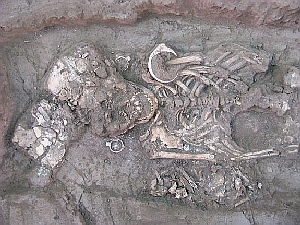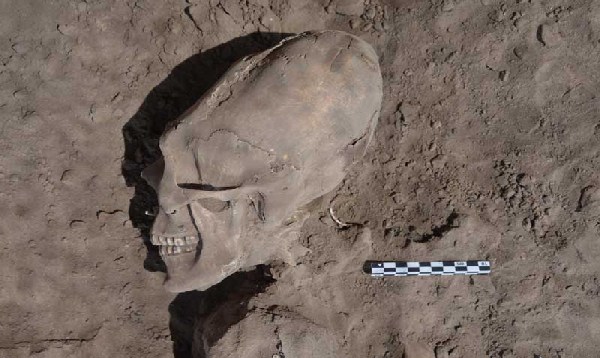Sonora, Mexico - Human skulls deliberately warped into strange, alien-like shapes have been unearthed in a 1,000-year-old cemetery in Mexico, researchers say.
Although the practice of deforming the skulls of children as they grew was common in Central America, these findings suggest the tradition spread farther north than had been previously believed.
The cemetery was discovered by residents of the small Mexican village of Onavas in 1999 as they were building an irrigation canal. It is the first pre-Hispanic cemetery found in the northern Mexican state of Sonora.
The site, referred to as "El Cemeterio," contained the remains of 25 human burials. Thirteen of them had deformed skulls, which were elongate and pointy at the back, and five had mutilated teeth.
Dental mutilation involves filing or grinding teeth into odd shapes, while cranial deformation involves distorting the normal growth of a child's skull by applying force; using cloths to bind wooden boards against their heads.
"Cranial deformation has been used by different societies in the world as a ritual practice, or for distinction of status within a group, or to distinguish between social groups," said researcher Cristina García Moreno, an archaeologist at Arizona State University. "The reason why these individuals at El Cemeterio deformed their skulls is still unknown."
 |
"The most common comment I've read from people that see the pictures of cranial deformation has been that they think that those people were 'aliens,'" García added. "It could be said that some are saying it as a joke, but the interesting thing is that some really do think so. Obviously we are talking about human beings, not of aliens."
Of the 25 burials, 17 were children between 5 months and 16 years of age. The high number of children seen at the site could suggest inept cranial deformation killed them due to excessive force against the skull. The children had no signs that disease might have caused their death.
Although cranial deformation and dental mutilation were common features among the pre-Hispanic populations of Mesoamerica and western Mexico, scientists had not seen either practice in Sonora or the American Southwest, which share a common pre-Hispanic culture. The researchers suggest the people at El Cemeterio had been influenced by recent migrants from the south.
"The most important implication would be to extend the northern boundary of the Mesoamerican influence," García stated.
A number of skeletons also were found with earrings, nose rings, bracelets, pendants, and necklaces made from seashells and snails from the Gulf of California. One person was buried with a turtle shell on the chest. It remains uncertain why some of these people were buried with ornaments while others were not, or — another mystery — why only one of the 25 skeletons was female.
During the next field season, the researchers aim to determine the cemetery's total size and hope to find more burials in order to get a clearer idea of the society's burial customs. With new information, they also hope to determine whether there was any interaction between these and Mesoamerican societies — how it was and when it happened.
García and her colleagues completed their analysis of the skeletal remains in November. They plan to submit their research to either the journal American Antiquity or the journal Latin American Antiquity.


